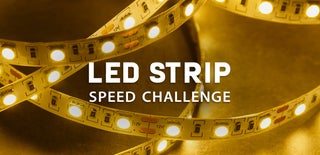Introduction: Simple LED Lightbox Cube
Hello everyone.
This time I'd like to share with you a model of the simple lightbox cube that could be used with open (to shoot the part of the large object) and closed sides for the small ones. This cube has a modular construction, could be easily disassembled and taken to any place you want. It could be easily stored by disconnecting top from the bottom, or the top part could be used separately, to produce a smooth light source to the scene. So let's start.
Supplies
* 8x50cm aluminum angle with 15x15mm and 1mm wall
* 4x50cm aluminum tube with 8mm in diameter
* (optional) +1x50cm aluminum tube with 8mm in diameter
* 2+2 meters of the White LED stripes with different brightness, e.g. like this and this
* 12v 5A power supply
* 1 x power connector, like XT60
* some AWG18 wires, solder iron with soldering supplies
* 3D printer
Step 1: Printing Corner Connector Model
I'd recommend placing the model like on the attached screenshot and print with supports that touch only the build plate. That will help save a lot of time from removing support material. It's better to choose plastic different from PLA because profile could heat up to 45 degrees which is bad for PLA, I printed with PETG and 20% infill.
Attachments
Step 2: Preparations
While the 3D printer is doing its job, we can use this tome and cut some metal, if that is required and perform some preparations.
First of all, we have to curve, a little bit, an edge on the corners to make assembly stable and rigid. That curve will increase the force which will be holding the aluminum extrusions in the plastic details with no screws used. So, all that we need is to create a dent/curve on each side of the extrusion, in about 20mm from the end, see photo for reference.
Step 3: Assembling the Bottom Part
Take the plastic corner connector, insert the aluminum extruded corner into its place and push. Repeat that for all 4 plastic details with 4 aluminum corners. You should get the square shape with places for the tubes, pointed in one direction. Insert the tubes in their places, see attached potos for reference. This step is done, we can move to the next one.
Step 4: Stick the LED Stripes and Solder the Wires
Stick the 2 LED stripe types with ≈41 cm length, by leaving the ≈45 mm from each side, on the different inner extrusion sides of the top cube's part. See the picture for the reference. We need this to achieve the different light density that comes from the edges.
To save some wires between the sections, you can solder the wire jumpers between the stripes.
Follow the marking labels and connect the all 4 extrusions in a closed-loop, using the 20 cm soft silicone wire pieces. Such lengths of the wires will help to disassemble the cure frame and store it in a small/compact place, without disconnecting the wires.
Use the rest 4 connectors and insert the all 4 extrusions into it, by paying attention that brighter stripe is looking inside the square.
Step 5: Check the Wiring
Check the wiring one more time on the top part, connect the power supply and turn it on. If everything was done correctly, you'll get something like on the reference photo, attached to this step.
Step 6: Test Shoots
Here are test shoots on white and green backgrounds. All photos were made without the closing sides with any material. Please share your thoughts about this.
Thank you for reading and happy photo shooting.
Step 7: Optional Models
BGHolder model is going to help with holding background.
Rods holder model helps to store all tubes when cube in disassembled mode and rods need to be stored securely.

Second Prize in the
LED Strip Speed Challenge














